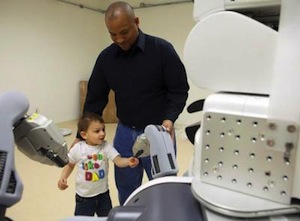
Chad Jenkins, left, explains how a robotic quadcopter can be controlled from an ordinary laptop, during a lab visit from U.S. Rep. David Cicilline. Cicilline later took it for a spin. Credit: Photos by Mike Cohea/Brown University
PROVIDENCE, R.I. [Brown University] — Chad Jenkins remembers the day when he knew he wanted to be a computer scientist.
It was December 25, 1981. At the age of 7, Jenkins woke up Christmas morning to find an Atari 2600 video game console and a Space Invaders game cartridge. That started an obsession with video games that Jenkins would eventually build into a career as a computer scientist and roboticist.
This Sunday, at the World Science Festival in New York City, Jenkins aims to inspire a new generation of kids to become computer scientists. He will be part of a "Cool Jobs" forum for youngsters gathered in NYU's Skirball Center for the Performing Arts.

"For me, it all started with video games," said Jenkins, now an associate professor of computer science and engineering at Brown. "I was inspired by them and I wanted to learn about them. That took me down the path of computing and engineering, and translated into the skills I needed to be successful as a computer scientist. That led to a love of innovation that eventually brought me to robotics."
Though he loved the games he played on his Atari, Jenkins was convinced he could make them better. So after programming rudimentary games of his own on an Apple IIe and 386 PC computers, he went to college as a double major in computer science and mathematics. From there, he went to graduate school to learn computer graphics.
It was while pursuing his masters degree that Jenkins made the transition from gaming to robotics. He worked with a researcher named Jessica Hodgins, whose work was at the intersection of graphics and robotics. "Instead of making physical robots, Jessica made animations that could simulate robotic systems based on real-world physics," Jenkins said. "That's how I started in robotics. I realized that it wasn't making games that I liked; it was innovation. It was making new technologies."
He went on to finish his Ph.D. at Georgia Tech under the direction of roboticist Maja Mataric.
In his lab at Brown, Jenkins develops software and interfaces that enable people to control and interact with robots efficiently. As he sees it, the problem in robotics today is one of control. Robots have all kinds of physical capabilities, but directing a robot to perform a task can require thousands of lines of complex programming. Jenkins wants to make controlling robots something that anyone — not just programmers and roboticists — can do with ease.
His main approach involves teaching robots to perform actions in much the same way humans learn to do things — through imitation. Jenkins starts by collecting data on how humans perform various actions. That data is then fed into machine learning algorithms that enable a robot to imitate the action. The more human examples the robot sees, the better it gets at imitating. The algorithms Jenkins has created have enabled robots to negotiate mazes and stack blocks in specific arrangements. He hopes ultimately to develop systems that can clean up a messy room, prepare a meal, or help people with disabilities perform basic tasks.
In his World Science Festival talk, Jenkins will show off some the devices he uses in his lab and the interfaces he uses to control them. With help from his 10-year-old daughter, Morgan Jenkins, he will demonstrate robot telepresence devices, quadricopter drones, and the PR2, a sophisticated robot designed for domestic service tasks.
All of the work Jenkins has done, he says, stems directly from a childhood obsession with video games. He hopes to show kids that making the leap from gamer to scientist is simply a matter of learning the basics of programming and combining it with some basic knowledge of math and science. Learning to program, he says, isn't so different from learning English composition.
"We learn grammatical forms and move to writing sentences and paragraphs and eventually essays," he said. "But in order to say something interesting, you need to make use of philosophy, history, and a broader range of human experience. In programming, we learn the basic syntax and that's how you start to express yourself through a computer. Then we use math, physics, and other physical sciences to do something interesting. Kids need to see how the things that they're learning in math class, or physics classes or other science classes can immediately be turned into cool things in terms of programming."
Making the programming plunge has never been easier than it is today.
"Everything that they need in terms of getting started in programming is on the web right now. There's never been a better time to acquire knowledge and apply it. Maybe they just need a spark."
- by Kevin Stacey